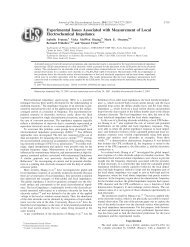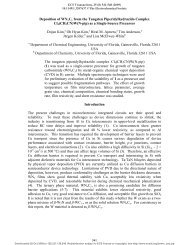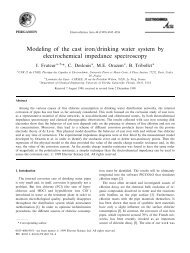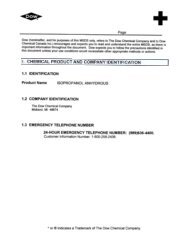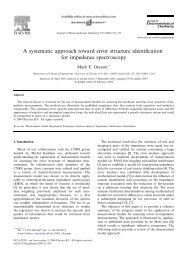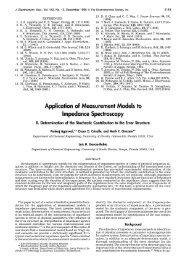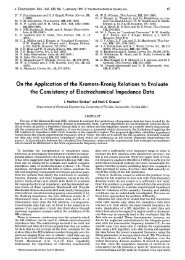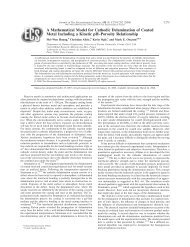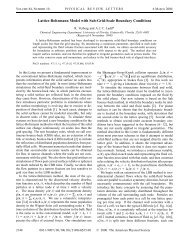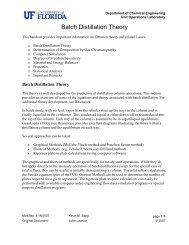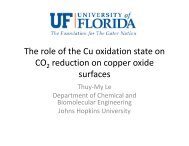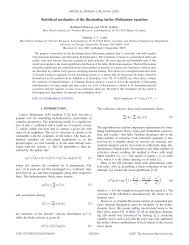PDF File - Chemical Engineering - University of Florida
PDF File - Chemical Engineering - University of Florida
PDF File - Chemical Engineering - University of Florida
Create successful ePaper yourself
Turn your PDF publications into a flip-book with our unique Google optimized e-Paper software.
FOAMING PROPERTIES OF SDS/LONG CHAIN ALCOHOL MIXTURES261FIG. 1. The effect <strong>of</strong> 5 mol% C n OH on the micellar relaxation time ( 2 )in SDS solutions at 25°C.tion <strong>of</strong> the molecular packing causing the micelles to destabilize.Hence, lower micellar relaxation times are obtained. Theeffect <strong>of</strong> 5 mol% C n OH on the micelle stability <strong>of</strong> 25 and 200mM SDS solutions is presented in Fig. 2. The effect <strong>of</strong> chainlength compatibility on surface properties, fluid displacementefficiency, and effective air mobility was investigated earlierby Shah and co-workers (14). They proposed that when thechain length <strong>of</strong> surfactant and cosurfactant are not equal theexcess hydrocarbon chain will exhibit thermal motion, therebyincreasing the molecular area at the air/water interface (Fig. 3).Apparently, a similar effect occurs in micelles (4).At a concentration <strong>of</strong> 25 mM <strong>of</strong> SDS or at approximatelythree times the CMC, the stabilizing effect <strong>of</strong> C 12 OH ismuch more significant than it is at 200 mM as shown in Figs.1 and 2. This indicates that the micellar stability <strong>of</strong> relativelylow concentration SDS solutions can be greatly enhancedby the addition <strong>of</strong> C 12 OH (at 25 mM almost 230times). The stabilizing effect <strong>of</strong> alcohol may be due toshielding <strong>of</strong> the negative charges <strong>of</strong> SDS with hydroxylgroups <strong>of</strong> the alcohol molecules and a stabilizing effect <strong>of</strong>the hydrocarbon tails, resulting in tightly packed micelles.However, at 200 mM the enhanced micellar stability resultingfrom the C 12 OH addition is very small, showing that thecontribution <strong>of</strong> C 12 OH to already stable micelles is notsignificant. A simplified schematic representation <strong>of</strong> theproposed micelles at 25 and 200 mM in the presence andabsence <strong>of</strong> 5 mol% C 12 OH is given in Fig. 4, which illustratesthe proposed effect <strong>of</strong> SDS and SDS C 12 OH concentrationon molecular packing in micelles and hence onmicellar stability.It is known that the stability or slow micellar relaxationtime <strong>of</strong> pure SDS micelles is a strong function <strong>of</strong> concentration.For pure SDS it has been shown that a maximum inmicellar relaxation time is observed at 200 mM (12). As theconcentration <strong>of</strong> SDS increases, the intermicellar distanceFIG. 2. The effect <strong>of</strong> 5 mol% C n OH on the micellar relaxation time ( 2 )<strong>of</strong> 25 and 200 mM SDS solutions at 25°C.decreases, resulting in a stronger electric repulsion betweenthe micelles. Therefore, the micelles become more rigid, dueto the compressive force <strong>of</strong> intermicellar repulsion andincreased binding <strong>of</strong> sodium ions. At 200 mM SDS, reducedfoamability, longer fabric wetting time, a maximum in gasbubble size and emulsion droplet size, and a maximum in oiland hydrophobic solids (dye) solubilization rates in micellarsolutions were observed (15, 16). These phenomena wereFIG. 3. Schematic diagram showing the effect <strong>of</strong> chain length compatibilityon molecular packing at the interface.
262 PATIST, AXELBERD, AND SHAHmM) the SDS/C 12 OH mixtures produced much less foamthan the pure SDS samples. This can be explained based onthe ability <strong>of</strong> micelles to break up in order to providemonomers to stabilize the newly created interface. Verystable micelles cannot break up fast enough to augment theflux <strong>of</strong> monomers necessary to stabilize the new air/waterinterface, resulting in higher interfacial tensions and, hence,foaming ability is low (Fig. 5D). So, apparently the break up<strong>of</strong> micelles is a rate-limiting step in the supply <strong>of</strong> monomersto the new air/water interface created by vigorous handshaking. At 200 mM the SDS and SDS/C 12 OH micelles areequally stable (see Figs. 1 and 5A) and, hence, equal foamvolumes are produced (Fig. 5D).FIG. 4. Schematic diagram showing the proposed effect <strong>of</strong> C 12 OH on themicellar stability in 25 and 200 mM SDS solutions at 25°C. (F) SDS molecule;(E) C 12 OH molecule.explained based upon the monomer flux to newly createdinterfaces. If the micelles in solution are very stable, theycannot provide monomer quickly to the surface and theinterfacial tension remains higher. However, if the micellesare relatively unstable, their disintegration provides monomersto the surface and a lower interfacial tension is obtained.The effect <strong>of</strong> C 12 OH on the SDS micellar stability wasrelated to the following interfacial properties: surface viscosity,equilibrium surface tension, and foamability (byshaking and air bubbling through a single capillary). Figure5B shows the results <strong>of</strong> the surface viscosity measurementsin the presence and absence <strong>of</strong> C 12 OH. From this graph itbecomes clear that a phenomenon similar to that whichoccurs in micelles (Fig. 5A) occurs at the air/water interface.At low SDS concentration (25 mM) the effect <strong>of</strong> C 12 OH ismuch more pronounced than it is at 200 mM. The alcoholcauses the molecules to pack tighter, resulting in a highsurface viscosity. However, at 200 mM the SDS moleculesare already tightly packed, which does not allow the alcoholto increase the surface viscosity significantly. The equilibriumsurface tension <strong>of</strong> 25–200 mM SDS solutions in thepresence and absence <strong>of</strong> 5 mol% C 12 OH is shown in Fig. 5C.It is clear that in the presence <strong>of</strong> C 12 OH the surface tensionis lowered by approximately 7 mN/m due to a closer packing<strong>of</strong> the molecules at the air/water interface. The alcoholdecreases the molecular area due to the ion–dipole interactionsbetween the SDS head group and the hydroxyl group<strong>of</strong> the long chain alcohol and a maximum hydrophobicinteraction between the carbon chains.Two different methods were applied for the foamabilityexperiments: vigorous hand shaking and air bubblingthrough a single capillary. Both methods show differentresults. In the first case, larger foam volumes were obtainedfor pure SDS solutions than for SDS/C 12 OH mixtures asshown in Fig. 5D. Especially at low SDS concentrations (25FIG. 5.solutions.The effect <strong>of</strong> 5 mol% C 12 OH on foaming properties <strong>of</strong> SDS
FOAMING PROPERTIES OF SDS/LONG CHAIN ALCOHOL MIXTURES263Foamability measurements performed by blowing airthrough a single capillary yielded different results. Figure 5Eshows that the foam volume <strong>of</strong> the SDS/C 12 OH mixtures isconsistently higher than that <strong>of</strong> pure SDS solutions, irrespective<strong>of</strong> the SDS concentration. Apparently, by using a singlecapillary the surfactant molecules have enough time to diffuseand stabilize the newly created air/water interface. Therefore, alower dynamic surface tension is obtained. The relation betweenthe dynamic surface tension and the amount <strong>of</strong> foamcreated is given by (17)W A, [2]where W is the work done, the interfacial tension at theair/water interface, and A the change in interfacial area.The same relation holds for emulsification processes (18).Obviously, when the same amount <strong>of</strong> work is applied, alower surface tension results in more interfacial area (eitherby decreasing the bubble size or by increasing foam volume),provided the presence <strong>of</strong> a surface active specie.Since the surface tension <strong>of</strong> the SDS/C 12 OH mixtures issignificantly lower than that <strong>of</strong> pure SDS (Fig. 5C), theformer one will produce more foam using the single capillaryfoam column.The results <strong>of</strong> the foamability measurements were evaluatedby a more quantitative experiment, namely, dynamicsurface tension by the maximum bubble pressure method.The understanding <strong>of</strong> dynamic surface tension is importantin any technological application where a new gas/liquidinterface is rapidly being created in a surfactant solution. Inmost cases the equilibrium surface tension is never reachedand the actual surface tension experienced at the air/waterinterface is much higher. The dynamic surface tension dependson several factors: monomer concentration (CMC),micellar stability, diffusion rate <strong>of</strong> the surfactant moleculeto the interface, and surfactant concentration. The measurement<strong>of</strong> dynamic properties is relevant to technologicalprocesses where an air/water interface is being formed, suchas foaming or film formation, as well as situations wheresurfactants diffuse to a new liquid/liquid interface, such asemulsification, or to a solid/liquid interface, such as fabricwetting. In this study two solutions <strong>of</strong> 15 mM SDS and onecontaining SDS 5 mol% C 12 OH were investigated. Aconcentration <strong>of</strong> 15 mM was chosen, since at too highsurfactant concentrations, deviations from equilibrium surfacetension are negligible at the bubble frequencies accessiblewith the current setup. The dynamic surface tension asa function <strong>of</strong> bubble lifetime (reciprocal value <strong>of</strong> bubblefrequency) is given in Fig. 6.The effect <strong>of</strong> 5 mol% C 12 OH is clearly visible: at higherbubble lifetimes the SDS/C 12 OH mixture shows a surfacetension significantly lower than that <strong>of</strong> pure SDS, indicatingthat the equilibrium surface tension <strong>of</strong> the SDS/C 12 OHFIG. 6. Dynamic surface tension ( D ) <strong>of</strong> SDS and SDS/C 12 OH mixturesat 25°C (15 mM SDS, 5 mol% C 12 OH).solution is much lower, which was observed earlier (Fig.5C). However, when the bubble lifetime decreases and thusthe bubble frequency increases, the curves are getting closerto each other up to a bubble life time <strong>of</strong> approximately0.15 s where they actually cross (Fig. 6). This means that atbubble life times smaller than 0.15 s (frequencies higherthan 7 s 1 ), the SDS/C 12 OH mixed micelles are not ableto augment the flux <strong>of</strong> monomers necessary to stabilize thenewly formed bubbles as compared to pure SDS. In thisregion the micellar stability, and thus the ability <strong>of</strong> micellesto break up fast enough, determines surface tension lowering.During the formation <strong>of</strong> bubbles, surfactant monomersadsorb onto the freshly created interface from the bulksolution. If the monomer is depleted by the adsorptionprocess, micelles must break up to provide additional monomers.If the micelles in solution are very stable, they cannotprovide monomer quickly enough and the dynamic surfacetension remains higher. However, if the micelles are relativelyunstable, their disintegration resupplies the depletedmonomer and lower dynamic surface tensions are obtained.In conclusion, for long bubble lifetimes the equilibriumsurface tension determines the interfacial tension at theair/water interface. However, when the bubble lifetime decreases,more and more monomer is depleted from the bulksolution and thus micelles have to break up in order toprovide additional monomers. In that case the break up <strong>of</strong>micelles, and thus the micellar stability, determines thesurface tension lowering.To show the importance <strong>of</strong> micellar break up in the dynamicsurface tension measurement, a dimensionless parameter wasintroduced, D eq w eq, [3]
264 PATIST, AXELBERD, AND SHAHFIG. 7. Dimensionless dynamic surface tension () <strong>of</strong> SDS and SDS/C 12 OH mixtures at 25°C (15 mM SDS, 5 mol% C 12 OH).where D is the dynamic surface tension, eq the equilibriumsurface tension as measured by the Wilhelmy plate method,and w the surface tension <strong>of</strong> pure water at 25°C (72.96mN/m). This equation normalizes with respect to the surfaceactivity <strong>of</strong> the solution. The denominator ( w eq ) can beconsidered as the effectiveness <strong>of</strong> the surfactant mixture(19). At 0, D eq , which indicates that the surfactantconcentration at the surface <strong>of</strong> the bubble is the same as thatunder equilibrium conditions. However, at 1, D w ,indicating that no surfactant is present at the interface <strong>of</strong>bubbles. Values between 0 and 1 are a measure for thesurfactant concentration at the surface, and hence, the stability<strong>of</strong> micelles, assuming the diffusion time <strong>of</strong> monomersto be negligible (20). The more stable the micelles, the lessmonomer flux and hence values closer to 1 will be obtained.Figure 7 shows the dimensionless parameter versusthe bubble lifetime for SDS and SDS/C 12 OH solutions <strong>of</strong> 15mM SDS and 5 mol% C 12 OH. In this graph the values areconsistently higher for SDS/C 12 OH than for pure SDS overall bubble lifetimes. Apparently, when accounted for thesurface activity <strong>of</strong> SDS and SDS/C 12 OH, the break up <strong>of</strong>SDS/C 12 OH mixed micelles is a rate-limiting step in highspeeddynamic processes. Therefore, it is very important toconsider the time scale <strong>of</strong> generating newly created interfacesin industrial processes, since that determines whetherthe break up <strong>of</strong> micelles and the dynamic surface tension arethe dominant factors in producing foams, emulsions, andwetting and solubilization processes.CONCLUSIONS1. Long chain alcohols (C n OH for n 8, 10, 12, 14, and16) stabilize SDS micelles, up to approximately 150 mMSDS (depending on the carbon chain length <strong>of</strong> the alcohol)due to the strong ion–dipole interaction between the negativelycharged SDS head group and the hydroxyl group <strong>of</strong>the alcohol. Beyond this critical concentration the chainlength compatibility starts playing an important role. Therefore,only C 12 OH will cause a further increase in micellarstability, whereas the mismatch in chain length between theother alcohols and the SDS results in a disruption <strong>of</strong> themolecular packing in the micelle, thereby decreasing thestability.2. The effect <strong>of</strong> adding C 12 OH is most pronounced when thestability <strong>of</strong> pure SDS micelles is very low, i.e., at low SDSconcentrations (25 mM). At higher SDS concentrations, themicellar stability increases, which makes the effect <strong>of</strong> C 12 OHless pronounced.3. The effect <strong>of</strong> micellar stability plays an importantrole in processes involving a rapid increase in surface area.If enough time is allowed for the interface to form, thedynamic surface tension approaches the equilibrium surfacetension and thus more foam is generated (more in case<strong>of</strong> SDS/C 12 OH mixtures). However, in very high speedprocesses, the micellar stability, and thus the time it takesfor micelles to break up, determines the rate <strong>of</strong> adsorption<strong>of</strong> surfactant molecules and therefore higher surface tensionswill be attained for SDS/C 12 OH solutions. In that caseless foam is generated, even though the equilibrium surfacetension <strong>of</strong> the SDS/C 12 OH system is lower. In conclusion,different methods <strong>of</strong> foaming can produce oppositeresults as illustrated by the foam-ability measurements inthis study.ACKNOWLEDGMENTSThe authors wish to express their thanks and appreciation to the NationalScience Foundation (Grant NSF-CPE 8005851), the NSF-ERC Research Centerfor Particle Science & Technology (Grant EEC 94-02989), and ICI Surfactantsfor their partial support <strong>of</strong> this research. Special thanks go to Dr. D. T.Wasan for his valuable suggestions on the manuscript.REFERENCES1. Shiao, S. Y., Chhabra, V., Patist, A., Free, M. L., Huibers, P. D. T.,Gregory, A., Patel, S., and Shah, D. O., Adv. Colloid Interface Sci. 74, 1(1998).2. Shiao, S. Y., Ph.D. Thesis, <strong>University</strong> <strong>of</strong> <strong>Florida</strong>, 1976.3. Shah, D. O., in “Micelles, Microemulsions and Monolayers” (D. O. Shah,Ed.), Chap. 1. Dekker, New York, 1998.4. Patist, A., Chhabra, V., Pagidipati, R, Shah, R., and Shah, D. O., Langmuir13, 432 (1997).5. Leung, R., and Shah, D. O., J. Colloid Interface Sci. 113, 484 (1986).6. Yiv, S., Zana, R., Ulbricht, W., and H<strong>of</strong>fmann, H., J. Colloid Interface Sci.8, 224 (1981).7. Aniansson, E. A. G., Wall, S. N., Almgren, M., H<strong>of</strong>fmann, H., Kielmann,I., Ulbricht, W., Zana, R., Lang, J., and Tondre, C., J. Phys. Chem. 80, 905(1976).8. Huibers, P. D. T., Oh, S. G., and Shah, D. O. in “Surfactants inSolution” (A. K. Chattopadhyay, and K. L. Mittal, Eds.), Dekker, NewYork, 1996.9. Wasan, D. T., Gupta, L., and Vora, M. K., AIChE J. 17, 1287 (1971).
FOAMING PROPERTIES OF SDS/LONG CHAIN ALCOHOL MIXTURES26510. Chattopadhyay, A. K., Ghaicha, L., Oh, S. G., and Shah, D. O., J. Phys.Chem. 96, 6509 (1992).11. Garrett, P. R., and Ward, D. R., J. Colloid Interface Sci. 132, 475(1989).12. Oh, S. G., and Shah, D. O., J. Am. Oil Soc. 70, 673 (1993).13. Lessner, E., Teubner, M., and Kahlweit, M., J. Phys. Chem. 85, 3167(1981).14. Sharma, M. K., Shah, D. O., and Brigham, W. E., Ind. Eng. Chem.Fundam. 23, 213 (1984).15. Oh, S. G., and Shah, D. O., Langmuir 7, 1316 (1991).16. Oh, S. G., and Shah, D. O., Langmuir 8, 1232 (1992).17. Adamson, A. W., “Physical Chemistry <strong>of</strong> Surfaces,” Chap. 2. Wiley &Sons, New York, 1990.18. Oh, S. G., Jobalia, M., and Shah, D. O., J. Colloid Interface Sci. 155, 511(1993).19. Rosen, M. J., “Surfactants and Interfacial Phenomena,” 2nd ed. Wiley &Sons, New York 1989.20. Oh, S. G., Klein S. P., and Shah, D. O., AIChE J. 38, 149 (1992).



